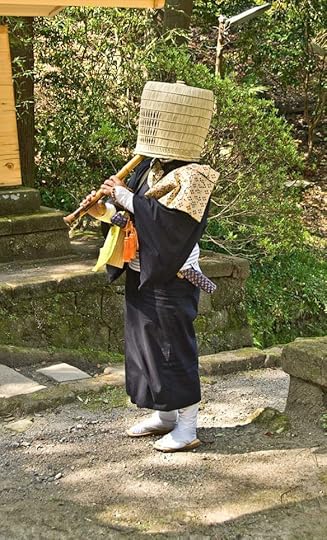Monday mood lifter – The Japanese have a word for this too…
By Gordon Rugg
Image from Wikimedia
Yes, it’s a picture of a man with his head in a basket, playing a very large bamboo flute.
Yes, the Japanese do have a word for it. Three words, in fact, because there’s a story behind why people went round with baskets on their heads, playing flutes. It’s a story of Zen and espionage and pentatonic scales.
The word for the man is komuso. The word for the basket is tengai.
Here’s what Wikipedia has to say on the subject.
The komusō (虚無僧 komusō?, Hiragana こむそう; also romanized komusou or komuso) were a group of Japanese mendicant monks of the Fuke school of Zen Buddhism who flourished during the Edo period of 1600-1868.[1] Komusō were characterized by a straw basket (a sedge or reed hood named a tengai or tengui) worn on the head, manifesting the absence of specific ego.
https://en.wikipedia.org/wiki/Komus%C5%8D
The word for the flute is shakuhachi.
It has a distinctive sound, and a keen following. If you ever wondered about the background music in the tiger scene in Manhunter, it’s Shriekback’s Coelocanth, featuring a shakuhachi as the opening instrument. The shakuhachi also features in the music of Tangerine Dream, Echo and the Bunnymen, Vangelis, and Sade, to name a few. If you like new musical experiences, it’s well worth investigating.
The full story of the Fuke monks and the shakuhachi includes some twists that would be hard to make up as fiction. Here’s one example, from the shakuhachi page on Wikipedia.
Travel around Japan was restricted by the shogunate at this time, but the Fuke sect managed to wrangle an exemption from the Shogun, since their spiritual practice required them to move from place to place playing the shakuhachi and begging for alms (one famous song reflects this mendicant tradition, “Hi fu mi, hachi gaeshi”, “One two three, pass the alms bowl”). They persuaded the Shogun to give them “exclusive rights” to play the instrument. In return, some were required to spy for the shogunate, and the Shogun sent several of his own spies out in the guise of Fuke monks as well. This was made easier by the wicker baskets that the Fuke wore over their heads, a symbol of their detachment from the world.
In response to these developments, several particularly difficult honkyoku pieces, e.g., Shika no tone, became well known as “tests”: if you could play them, you were a real Fuke. If you couldn’t, you were probably a spy and might very well be killed if you were in unfriendly territory.
I hope that this knowledge has brought pleasure to your Monday.
Source
The featured image is from Wikimedia:


Gordon Rugg's Blog
- Gordon Rugg's profile
- 12 followers




